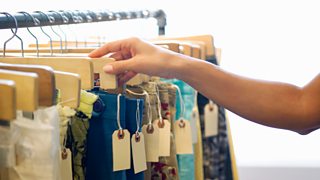Swapping, second-hand and sustainability: Mary Portas on the future of fashion
The world is changing. Fashion retail was built on the mantra “big, fast, cheap and profitable.” But the world has shifted and now we’re demanding style that goes deeper. Now, many of us are asking how innovative is our clothing? How creative? How sustainable? And how kind to our planet?
In Mary Portas: On Style, the retail guru talks to a swathe of characters from across the clothing world about the future of fashion. Here are a few of the things we learnt.

-
![]()
Mary Portas: On Style
Retail guru Mary Portas talks to a swathe of characters from across the clothing world about the future of fashion.
We want greater transparency on where our clothing is from
The Rana Plaza garment factory fire in Bangladesh in 2013, in which over a thousand people died, raised awareness around the real, devastating cost of fast fashion. The people making the clothes we wear are often grossly underpaid, overworked and dangerously unsafe.
Fashion Revolution is a campaigning organisation that was established in response to the fire. Carry Somers, co-founder and Global Operations Director, wants changes in the way fashion works, with greater transparency on exactly how our clothes are made. She says many of us are starting to reject the idea of fast fashion. “We don’t think enough about it, but we are starting to,” says Carry. “People are really starting to ask questions.”
The younger generation are also looking for experiences and seeking connections when they shop, says Carry. They’d much rather work directly with the artisans, get something customised, or be able to go into a studio and see where something is made. Transparent is the new black.
What you wear can have the same amount of plastic as 25 bottles

Winifred Robinson speaks to fashion designer, Henry Holland, about the amount of plastic in our clothes.
Second hand shopping is big business
As a move away from fast fashion, many of us are rejecting the high street retailers and choosing to shop in vintage and second hand stores. It’s a trend that’s being pushed by campaigns like , organised by the charity Oxfam, which encourages people to avoid buying new clothing for the entire 30 days of the month with an aim to raise awareness of the environmental impact of fashion. And not only is second hand shopping sustainable, it also provides the unparalleled thrill of picking up a bargain designer item. Stella MaCartney skirt for a pound, anyone?
Young people in particular are choosing to swap clothes, organise clothing exchanges, use designer resale sites and buy on , and . Every day, more and more platforms are springing up, giving people new ways to sell their used clothing.
Carry Somers gives a sense of just how big second-hand has become: “In the last three years, the fashion resale market has outperformed the fast fashion market and they are estimating that within the next decade that resale will be bigger than fast fashion.”
Could you buy all your clothes second-hand?

Winifred Robinson finds out why people are buying more of their clothes second-hand.
Weβre going to start caring for our clothes differently
We’re beginning to realise the environmental impact that fashion has as an industry and just how polluting our textile processing is. But there’s also more dialogue around the impact our clothing care at home has on the planet. For example, a third of the carbon footprint of clothes comes from the way we care for them, with excessive washing and dry-cleaning.
A third of the carbon footprint of clothes comes from the way we care for them, with excessive washing and dry-cleaning.
Fashion Revolution has created a new wall planner for 2020 with the stirring title “366 days of fashion revolution.” It’s full of tips for the green steps we can take as individuals, including suggestions for how to clean and care for our own wardrobe more responsibly.
Most of our garments don’t need cleaning half as much so it’s time to give the washing machine a rest. Will it soon be cool to smell of last night’s dinner? We reckon so.
Fashion labels are looking for sustainable solutions
At London Fashion Week in 2019, made waves not just for the clothes she'd made but the work involved in designing her label's most sustainable collection. She started her label in 2011 but then stood down from three seasons of fashion shows in order to research the best ways of ensuring her label was using sustainable materials and minimising waste.
The first thing the company altered was their packaging – eliminating any plastic when sending out their products. Then, they moved on to waste. They now work with schools and universities who reuse their scraps in their art departments, as well as organisations who help refugees to make their own clothing from the label’s larger off-cuts. They’ve also developed their pattern cutting techniques in order to reduce the waste produced in the first place. They’ve shifted from buying virgin resources (new fabrics) to using a majority of fabrics already in existence and they have stopped using virgin polyester, acetate and acrylic – anything made from crude oil. They have also ditched zips because a lot of chemicals go into the manufacture of anything metal.
How do fashion brands deliver the latest trends so quickly?

From the design to the shop, what is 'fast fashion' and how do top brands turn it round in double-quick time?
Perhaps most importantly, Phoebe has done something most designers won’t: opened up her studio to competitors.
They are estimating that within the next decade the fashion resale market will be bigger than fast fashion.Carry Somers, co-founder and Global Operations Director of Fashion Revolution
Most fashion houses want to keep their collections under wraps until that first catwalk show but Phoebe’s team are sharing knowledge, sharing contacts, and looking at how we can make fashion better for the future.
She realised that lots of other retailers were looking for sustainable solutions and she had many of the answers. “My team learning these things and us putting solutions into place is entirely futile if we’re not doing it together,” she says.
Weβre looking back to the era of βmake do and mendβ
For some, a missing button or a fabric tear means that a garment is destined for the bin. But this hasn’t always been the case. We used to darn, patch and stitch our damaged clothing to give it a second lease of life, and it’s something we’re learning to embrace again. For sustainable ways of making, caring for and enjoying fashion it’s seems it’s a case of looking back as well as looking forward.
Phoebe English says her grandma always looked pristine and stylish, even though she had very few items. This is because they were perfectly kept, beautifully mended and really valued. “I think there definitely is something to be said for doing things the way we used to do them, when we really valued and treasured a very beautiful coat and we repaired it and we looked after it and we cleaned it properly and it came back winter after winter,” says Phoebe. With her own range, Phoebe asks customers to return items if they get damaged in any way so they can be repaired and continue their life for as long as possible.
Will the 2020s usher in a new era of make do and mend?
How effective are the campaigns for sustainable fashion?

How one retail giant is on a mission to become more environmentally friendly.
More from Radio 4
-
![]()
Mary Portas: On Style
Retail guru Mary Portas talks to a swathe of characters from across the clothing world about the future of fashion.
-
![]()
10 fashion ideas that will help save the planet
For the fashion-loving consumer who wants to go green, here are ten trends and tips.
-
![]()
How Stella McCartney changed the way you dress
Five ways tha Stella's designs inspired the clothes you wear.
-
![]()
FutureProofing: Fashion
How technology and social change could mean the end of fashion.




